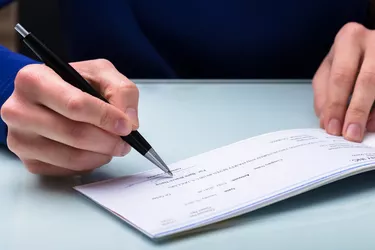
If you take a look at your checkbook, you'll see at least three different numbers on each check. Two of these, the routing number and account number, are the same on each check and work to identify your bank and your individual account so the money gets drawn from the right place. Another number is the check number, which is a serial number that identifies the individual checks to make it easier to maintain your records.
How Checks Work
Video of the Day
A check is a legal document that requests that your bank pay the dollar amount you've written on it to the person or business you've indicated when it's presented. Nowadays, it's also the start of a sophisticated electronic payment process that's largely handled by computers and scanners rather than human clerks who ran bank back offices in the not-too-distant past.
Video of the Day
Checks are usually scanned by the person or business who received them, using industrial equipment in the case of large businesses and smartphone apps in the case of individuals or small businesses, or by the bank when they're deposited. The ink and writing spelling out the account and routing numbers on checks are designed to be easily read by machines rather than humans. The numbers on a check are processed with a system called optical character recognition.
Once a check is imaged, the bank receiving it works directly with the bank that issued it or through the Federal Reserve's clearinghouse system to get the money transferred to where it needs to go. This can take a few days, which is why you sometimes don't have access to the money you deposited in your account right away.
Routing Number and Account Number
Usually, at the bottom left of a check, you will find what is called a routing number. This is a number that identifies your bank and is used to locate your account. Some big banks have multiple routing numbers, so if you have an account with, say, Chase or Bank of America and you need to provide someone with your checking account information, you should make sure you use your specific routing number rather than any Bank of America routing number.
The next number you will see on your checks is your account number. This is issued by your bank and is specific to your bank. Wells Fargo can issue a Wells Fargo account number according to its own standards, and Citibank can use its own standards for generating account numbers.
Your routing number and account number together uniquely identify your account. They're often necessary to transfer money to and from your account, which is why they're included on your checks and sometimes used to make online purchases from your bank account or to set up direct deposit from an employer. But because they can be used to transfer funds from your account, you should safeguard them as best as you can to prevent them from falling into the hands of thieves.
Your Check Numbers
Each check in your checkbook has a unique check number. When you order new checks, your bank will usually send you a new pack starting with the next sequential number.
These numbers are mostly provided for your convenience. You can write down the check number in a paper check register or track it in a digital accounting app so that you know which checks you have sent to whom for what.
If you end up with multiple checks with the same number due to a clerical error or some other reason, it can potentially cause confusion, although banks will often allow you to use multiple checks with the same number. This also means you should safeguard your returned check and anyone else's checks you have scanned to deposit, since fraudsters could alter them to cash them again and steal money.